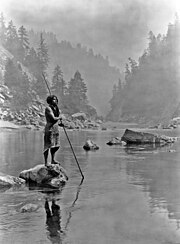|
Salvage ethnography
Salvage ethnography is the recording of the practices and folklore of cultures threatened with extinction, including as a result of modernization and assimilation. It is generally associated with the American anthropologist Franz Boas[citation needed]; he and his students aimed to record vanishing Native American cultures.[1] Since the 1960s, anthropologists have used the term as part of a critique of 19th-century ethnography and early modern anthropology.[2] EtymologyThe term "salvage ethnography" was coined by Jacob W. Gruber, who identified its emergence with 19th-century ethnographers documenting the languages of peoples being conquered and colonized by European countries or the United States. According to Gruber, one of the first official statements acknowledging that a major effect of colonialism was the destruction of existing languages and ways of life was The report of the British Select Committee of Aborigines (1837). As a scholarly response, Gruber quotes James Cowles Prichard's address before the British Association for the Advancement of Science in 1839, referring to the Old Testament tale of Cain and Abel:
Conservation and art Frances Densmore (1867–1957), an influential ethnomusicologist, worked in the tradition of salvage ethnography. Densmore recorded the songs and lyrics of Native Americans in an attempt to preserve them permanently. Many of her original recordings, preserved on wax cylinders, are archived at the Library of Congress. Artists compounded the work of professional anthropologists during this time period. Photographer Edward S. Curtis (1868–1952) was preceded by painter George Catlin (1796–1872) in attempting to capture indigenous North American traditions that they believed to be disappearing. Both Curtis and Catlin have been accused of taking artistic license by embellishing a scene or making something appear more authentically "Native American". Curtis notes in the introduction to his series on the North American Indian: "The information that is to be gathered ... respecting the mode of life of one of the great races of mankind, must be collected at once or the opportunity will be lost." Salvage ethnography started to be applied methodically in visual anthropology as ethnographic film since the 1950s by filmmakers such as Jean Rouch in France, Michel Brault and Pierre Perrault in Canada, or António Campos in Portugal (early 1960s), followed by others (1970s). Salvage ethnography is often taught in film and media studies courses as a style of filmmaking that captures a civilization or people's former way of living. The best example of this would be Robert Flaherty's Nanook of the North. In Nanook, Flaherty staged incidents and scenes that did not fairly represent the Inuit tribe's current way of life, but rather their "former majesty". See also
Related people
References
Further reading
|
